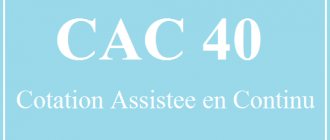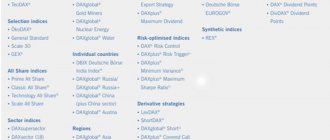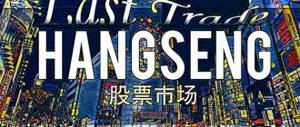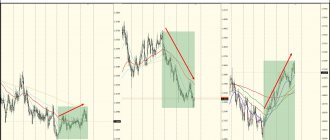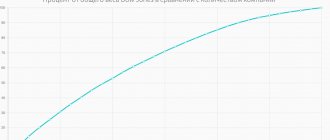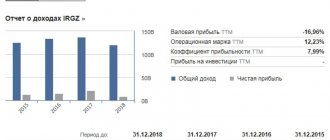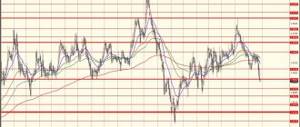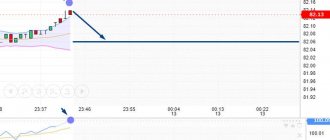NIKKEI 225 index online chart
The Nikkei Index is the most important Japanese stock index, and it is quite interesting that the index used to have a long name and only since 1970 has it been called from the name of the newspaper. The index includes 225 companies, and the index itself is calculated as the arithmetic average of the prices of these shares. On the presented chart you can observe the values of the NIKKEI 225 Index online in real time.
Nikkei Index online
As we noted above, this is the stock index that is the most important for Japan. The index includes 225 companies, but the list of these companies is revised once a year. The stock index itself has been calculated by the newspaper since 1970, the newspaper is called Nihon Keizai Shimbun, which is where the name NIKKEI comes from.
Which companies are included in Nikkei 225
The Nikkei index contains 225 leading Japanese companies from more than 30 industries. It is remarkable because most of them belong to the real economy, which means the stability and longevity of the Nikkei. Among them are dozens of well-known world leaders, such as Mitsubishi Corp., Mazda Motor, Honda Motor, Isuzu Motors, Kikkoman Corp., Nissan Motor, Hitachi, Sony, Canon and many others.
That is why Nikkei 225 is so loved by traders from all over the world. In addition, its high volatility is a good opportunity to make money if you approach this with a certain degree of caution.
Nikkei leaders in percentage terms among participants at the moment are Mizuho Financial, Mitsubishi UFJ Financial Group, Nomura, Panasonic, Tokyo Electric Power, Resona Holdings.
The list of companies included in the Nikkei 225 index is revised once a year, in September, but very limitedly - no more than 6 at a time. This, of course, is a purely conservative approach, given the explosive growth of Asian markets.
What does Nikkei mean?
In essence, Nikkei is a reflection of the state of Japanese industry, since most of the companies included in it are large-scale industries. Their number is determined as 225. Thanks to the explosive post-war development of the Japanese economy, many of the index participants entered the world stage, where they still remain.
This factor also contributed to the Nikkei 225 becoming equal in popularity to the American Dow Jones. The main role in Nikkei is played by companies whose total share value and, accordingly, capitalization is higher.
Nikkei 225 rate chart online – Price for today and all time
Working with Nikkei 225 is convenient for traders investing in the real sector of the economy and, especially, in developing companies. A large volume of innovative research can make a small office a market leader and generate multimillion-dollar revenues. The connection with the Dow Jones calculation system adds convenience.
The history of the Nikkei 225
The Nikkei 225 index was created by the Nihon Keizai Shimbun
Company Value
on September 07, 1950 . The starting date was chosen as May 16, 1949, and 100 points were taken as the basis - it was on this day that the Tokyo Stock Exchange opened after World War II, and the Far Eastern Commission stopped collecting reparations from Japan on May 12.
The development of stock trading in Japan was proceeding at a brisk pace, adding tens of percent per year. In 1975, there was a slight recession caused by the world fuel crisis, and an agreement was concluded between the Tokyo Stock Exchange and Dow Jones to use the American system of calculations. From 1975 to 1985, the full name of the index was Nikkei Dow Jones Average
.
Maximum Nikkei 225
fell on December 1989 - 38,957.44 points.
To be fair, let’s say that not only the development of the Japanese economy had an impact here, but also access to other markets. the Osaka Securities Exchange
in 1988 , and on the Chicago Mercantile Exchange in 1990.
While humanity was celebrating the New Year 1990, the Nikkei 225
flew down with the elegance of an iron. During the nine years that Japan showed growth in industrial production, the index fell further, reaching 7,054.98 in March 2009, down 81.9% from 20 years earlier. In 2011, after the earthquake near Fukushima, it fell by 10% to 8,160.01.
The long-awaited revival began in 2013, when in five months the range of 10,600 - 15,492 was passed. Soon there was another drop, by the same 10%, and again an increase - to 20,584.24 in July 2015. And then the crisis hit in Asia, where the assembly plants of many Japanese companies are located, and the beginning of 2021 was met with a drop of 3,000 points in less than three weeks.
Make money on the Nikkei 225 index
It doesn't take much time to make money on an index. The only difficulty for European residents will be during inconvenient trading times - almost at night. We chose not just an index future as an instrument, but a binary option on a futures. It is this instrument that will provide us with fixed profit in a short time.
We opened this page and selected Nikkei 225:
The end time of the transaction was set to 17:35
:
After analyzing the current trend, we decided that the asset would grow and opened a trade UP
– with the condition that the price increases by half an hour:
If at the end of the transaction the index increases in price, no matter how much, we will receive a 65% profit.
After 17 minutes, the option closed automatically and the broker issued the result:
The Niikei 225 rate has grown, the UP option condition has been fulfilled, our net profit was $45.5:
Nikkei 225 calculation method
The Japanese stock index completely copies the American Dow Jones in its formula. In the given formula:
Nikkei 225 = ∑p/d
- ∑р — total value of 225 shares included in the index;
- d is a floating divisor that is calculated continuously.
Nikkei 225 = ∑pt0 / d0 = ∑pt1 / d1
The divisor changes every time there is an issue of shares, an increase or decrease in the free fleet, mergers, acquisitions and changes in the composition of participants. Thus, the capitalization of the index depends both on changes in the value of shares and on the composition of the divisor. In this formula:
- ∑pt0
is the total value of shares included in the index at time 0; - d0
—divisor at moment 0; - ∑pt1
is the total value of shares included in the index at time 1; - d1
is the divisor at time 1.
The Nikkei 225 divisor, as of September 30, 2015, was 25,492, before this adjustment took place a year earlier in September 2014, then the divisor was determined to be 25,473. Considering that on January 21, 2021, the index dropped to 16,017.26, all 225 shares in total cost 0.62 currency units.
This, in fact, is why Nikkei 225 is criticized: a small number and a bias towards the high-tech sector. Despite the economic storm sweeping Southeast Asia, index members change only once a year, and then - no more than six stocks at a time. But there are 35 “sub-indices” and the TOPIX grouping.
Interesting Facts
- As of the beginning of 2021, the Nikkei 225 capitalization was 4.5 trillion. US dollars, which is equal to 2/3 of the entire capitalization of the Tokyo Stock Exchange.
- The total volume of securities sales approached the mark of 7 trillion. US dollars and, despite the passive sentiment of investors, is only increasing (due to the bears).
- In addition to the traditional name Nikkei Heikin Kabuka, the English expression Nikkei Stock Average is present in business circulation.
Features of the Nikkei 225 Index
The Nikkei includes 225 of the country's largest companies, and the index is considered the best in the world in terms of diversification. There are 35 sectors in total, the most powerful of which (29 participants), as expected, is electrical and electronics. The chemical sector is developed - 18 companies, mechanical engineering - 16, there are 11 banks and nine car manufacturing companies.
of chaebols in the material about the Korean KOSPI index
- industrial and financial conglomerates owned by the same family and operating under the same brand.
The Japanese analogue is called zaibatsu, and within the same Nikkei 225, entire groups can be distinguished: Nippon
is represented by 12 companies,
Sumitomo and Mitsubishi
- nine,
Mitsui
- six,
Fuji
- five.
Another feature of the index is the large multidirectional movement of the participants’ shares - this is due, as mentioned above, to serious research of each of the participants. For example, on January 21, 2021, when the Nikkei 225 quote fell by 2.5%, a number of companies showed a disproportionate rise: Asahi Glass
and
Sharp Corp
- by 5.02% and 7.79%, respectively.
Trading on the Nikkei 225 index takes place from 09:00 to 15:00 local time or from 03:00 to 09:00 Moscow time. There is a break - from 11:30 to 12:30 - previously it was used for clearing operations, now for lunch and rest.
As one of the influencing factors, we note the orientation of the Japanese country towards the export of goods produced in the country. The Japanese economy is primarily dependent on the level of exports to the United States. In this regard, the Nikkei 225 is a kind of reflection of fluctuations in indices that include American companies, as well as changes in the US market.
Advantages of the Nikkei 225 Index
- a large number of companies in the real sector;
- calculations using the authoritative Dow Jones methodology;
- knows how to quickly recover from crises;
- included in the top five key indices in the world;
- has the second, after nyse, capitalization.
Nikkei 225 index dependencies
- extremely dependent on China due to the location of assembly plants there;
- the crisis in Japan is having an impact;
- has a direct competitor TOPIX;
- is trading at an inconvenient time for the US and Europe.
Reliable broker for trading binary options
- FiNMAX
Professional options broker FiNMAX offers binary options on stocks, indices, commodities and currencies (+cryptocurrencies). Profit for each transaction from 70%
. Option periods range from 30 seconds to 6 months. No platform installation required on PC.
The broker is regulated by the Center for Financial Markets
.
The minimum deposit to open an account is $250
, the minimum transaction is $10.
Website
: FiNMAX
Conclusion
Working with the index will be of interest to traders who play to reduce quotes, as well as those who risk connecting their business with high technologies. Along with NASDAQ, Nikkei 225 has become a platform for the growth of a large number of hi-tech
companies in which investments brought tens of thousands of interest.
However, given the anxiety in the Japanese stock market, the Nikkei 225 should be cautious.
(
10
ratings, average:
4,60
). Please rate us, we tried very hard!
How and where to make money on the index
Nikkei 225 is available for trading on four platforms:
- Tokyo Stock Exchange.
- Osaka Stock Exchange.
- Chicago Stock Exchange.
- Singapore Exchange.
So you can trade this instrument through:
- a “daughter” of a reliable Russian broker, which must be registered in the Asian region or the United States;
- a foreign broker who works on the listed sites and gives clients access there.
Rick Keith Opening CapTrader Exante
The oldest Russian broker, operating since 1994. An excellent choice for those who want to connect to autofollow. Pros:
- no annoying calls with offers to spend money;
- own trading platform;
- impressive results of strategies (+74% for 2021) that you can connect to.
Of the minuses:
- no Quik.
You can read the full review here.
A good broker for a beginner. Here I hold the Russian part of the investment portfolio from an ETF from FinEx on an IIS.
The broker pleases:
- low commissions and the absence of annoying calls with offers to spend my money.
Of the minuses:
- weak personal account and inconvenient system for annual key regeneration.
The review can be read here.
Another great broker with whom I worked for more than 2 years. This is where I traded on FORTS.
Pros:
- Reasonable commissions
- Excellent personal account
- Nice free services
The downside is the broker's love of calling people trying to sell something.
The review can be viewed here.
German IB introducing broker for direct access to foreign markets. This is where my investment portfolio is located.
Pros:
- Works with Russians
- Availability of a Russian-language version of the site
- Reasonable commissions
- No inactivity fee
- Insurance under US law for $500k
The disadvantages include:
- Support exclusively in English and German
- The support service itself is poor
For a detailed review, see this post.
Another interesting broker for going abroad, and not from the IB family. Unfortunately, contracts are opened for Russians only in Cyprus.
Pros:
- Acceptable commissions
- The fact of successful verification of work by the SEC
- Russian-language website and support
On the downside:
- Cyprus jurisdiction
- Inactivity fee
Read a detailed review here. You can get a $500 bonus when opening an account here.
You can choose futures or ETFs as tools for working with Nikkei. Of the latter, the largest are:
- NEXT FUNDS Nikkei 225 Leveraged;
- Daiwa ETF Japan Nikkei 225 Double Inverse;
- HAREL NKY 67;
- Nomura Nikkei 225 Listed.
Warning about questionable ways to make money on Nikkei 225
Useful articles
How to choose the right instruments and fill a passive investment portfolio?
Step-by-step instructions: how can an investor fill out a 3-NDFL declaration and pay taxes?
6 ways to profitably invest 100,000 rubles in 2021
TOP 4 successful ideas on how to start your own business without investment or with minimal costs
I cannot ignore this burning topic.
It seems that everything is simple - free cheese can only be found in a mousetrap. But no, there are thousands (I’m afraid to talk about more) of those who believe in instant earnings such as binary options and trading in forex “kitchens” of various kinds. Well, just a win-win lottery for suckers!
Comrade investors, you are all adults, ask yourself a question - what is the benefit of a so-called broker who trades in binary options? Here I constantly make comparisons with online casinos. Is it beneficial for the casino owner for you to win over and over again? Is he interested in his clients losing a ton of money every day?
Such brokers also work according to the casino principle. This is true. Why don’t you bring your hard-earned money to the casino, but to the “optionists” and the organizers of the forex “kitchens”? After all, there is no difference between them - the meaning of the work is the same, and the advertising is similar. Clear as day.
Therefore, let's unite and together deprive these extortionists of their earnings. At least we won’t stand in a long line called “but I was warned.”
Basic stock quotes
| MICEX Index | 3 539,50 | 0,00% | 01:59:59 |
| PTC Index | 1 519,50 | 0,95% | 18:50:00 |
| DOW.J | 32 478,60 | -0,92% | 00:00:55 |
| NAS100 | 12 935,00 | -0,02% | 00:00:55 |
| S&P 500 | 3 942,53 | -0,02% | 00:00:55 |
| NIKKEI | 29 730,80 | 0,04% | 23:56:33 |
| DAX | 14 566,90 | 0,44% | 00:00:55 |
| ESTX50 | 3 850,58 | 0,45% | 23:58:44 |
| EUR/RUB | 87,4764 | -0,09% | 08:07:17 |
| USD/RUB | 73,2633 | -0,19% | 08:07:17 |
| CHF/RUB | 78,7862 | -0,23% | 08:07:17 |
| GBP/RUB | 102,0045 | -0,19% | 08:07:17 |
| BTC/USD | 59 671,10 | 0,58% | 08:07:17 |
| BCC/USD | 556,8449 | -0,84% | 08:07:17 |
| ETH/USD | 1 858,26 | 0,13% | 08:07:17 |
| Gold | 1 723,08 | -0,22% | 00:00:55 |
| Silver | 25,85 | -0,69% | 23:41:15 |
| Copper | 4,15 | -99,95% | 00:00:55 |
| Oil | 69,23 | 0,00% | 00:00:55 |
Cost and dynamics for all time
The Nikkei 225 quotes chart speaks for itself - this is a very fast “horse”. And until 1990, she quickly jumped up. Surely many venerable investors managed to significantly increase their capital during this Nikkei “race”. In December 1989, a historical maximum was set at 38,957 points.
However, since January 1990, the index has fallen at the same speed. Having reached a low of 14194 in August 1992, the Nikkei turned around again, and also sharply. Then there was a series of ups and downs, as a result of which the index periodically updated its lows. The historical minimum was recorded in April 2003 - 7607 points.
Since the fall of 2012, the Nikkei 225 has again begun to grow and feed investors' hopes. Although the Nikkei has stalled somewhat at 23,000 recently, the overall trend remains bullish and the instrument itself is attractive.
Nikkei calculation method
Speaking about the method by which the Nikkei is usually calculated, we can safely mention the Dow Jones, since it is its exact copy. It was the Americans who in 1975 suggested that the Japanese adopt for their key indicator the same formula that is used for the Nikkei opponent in the United States. No one seems to have spoken out against it.
Since then, the Nikkei index has been calculated using the arithmetic mean:
It turns out that what is important for calculation is mainly the cost of shares and their number in circulation. That is, the most important influence in percentage terms is exerted by companies with the largest capitalization.
Nikkei 225 index stock quotes change every 15 seconds in real time.
Connection with the foreign exchange market
The pattern of contact between a stock index and currency pairs or binary options can be traced quite quickly, although it seems too complicated for beginners. The Nikkei 225 Index is calculated in yen, while investment and all exchange assets are traditionally denominated in dollars. That is, the valuation of any investment in Nikkei 225 assets depends on the USD/JPY exchange rate.
That is, if an investor buys shares of a Japanese corporation, he will be able to conduct a transaction, for example, on the TSE, only in Japanese currency. The forced conversion of capital causes an increase in demand for it. And vice versa, the larger the volume of currency that is sold - no matter for what purpose - the cheaper it “costs”. During periods when the Japanese stock market seems profitable to investors, more money flows into it from outside; if there is any doubt about the efficiency of the economy, investors will sell shares and exchange the yen for the dollar, euro or yuan. The yen is correspondingly weakening.
The movement of the Nikkei 225 seems unpredictable due to the number of different stocks, but in reality it is enough to have a good understanding of what correlation is.
Pros and cons of the index
When you take the risk of making money on the Nikkei 225, do not forget about its pros and cons.
The advantages paint a tempting prospect:
- It occupies a place of honor among the top five key global market indices.
- Nikkei 225 is a leader in diversification.
- It is included in the top two global indices in terms of capitalization level.
- Has high volatility.
Well, a fly in the ointment in the form of the disadvantages of this tool:
- The opening hours of the Tokyo Stock Exchange are not particularly convenient for residents of the European part of Russia - trading runs from 3 to 9 am.
- The main competitor of Nikkei 225 - TOPIX - at times props it up quite noticeably.
- It is highly dependent on the state of the Chinese economy, since Japanese production facilities have many branches on its territory.
What affects the price
The dynamics of quotes of the popular Japanese Nikkei 225 index are influenced by the following factors:
- Movement of American indices.
- The ongoing economic crisis in Japan.
- Cataclysms and other force majeure external circumstances affecting the Japanese islands (for example, after the Fukushima accident in 2011, the Nikkei immediately dropped by 10%).
The Nikkei index itself is quite stable and at times shows good growth even against the backdrop of negative news.
The appearance of the index
The Nikkei index was first introduced to traders in 1950, making it the oldest economic indicator in the Asian region. This instrument owes its name to a Japanese printed publication that was very respected in its time, which covered events in financial markets and presented Nikkei to the world community. By the way, it was this publication that began to calculate and publish the value of the index, which was watched with interest by all economists in the world.
Forecast, analytics and prospects
If you are not confused by the “jagged” pattern of quotes for this instrument, feel free to add it to your cart. Like most Japanese indices, Nikkei is very volatile and therefore provides good opportunities for making money.
The Nikkei 225 is Japan's most popular stock index, a sort of Asian Dow Jones. For this reason alone, it is worth investing in. The Nikkei is really promising, with good movement and headroom at the top. But with a sudden drawdown you need to be careful.
Loading …
In addition, when working with this tool, it is necessary to constantly monitor changes in the political and economic environment of Japan, since any more or less significant events can “play” the Nikkei down.
The Nikkei index is different in that it is relatively easy to make a forecast for it. Some people also do not neglect indicators - by the way, the Ichimoku indicator was specially developed for it, which some traders do not hesitate to use.
As for the strategy of investing in indices, I stand by my opinion - these are long-term investments, with a planning horizon of 3 years. So be patient with Nikkei 225 and you will be rewarded for your efforts.
How to trade using an index
The Nikkei 225 has traditionally had strong exposure to a variety of assets, such as the UK100 (+75.5%), US30 (+72.8%), or the HKD/JPY (+75.6%), USD/JPY ( +72.5%), AUD/JPY (+69.2%); as well as an inverse correlation with the EUR as the base currency: EUR/NZD (−65.2%), EUR/AUD (−64.5%). The main thing is to understand who is ahead of whom at the moment.
The Dow Jones Industrial Average (DJIA) moves quite synchronously with the Nikkei, although sometimes the movement of one index is clearly ahead of its companion, but in the end such signals are always processed.
Among the commodity assets that have a serious impact on the Nikkei, it is worth noting copper - a strategically important industrial raw material for the entire Asian region. Those who actively work with Aussies know very well that AUD/USD can sharply fall by 1-1.5 figures at the close of Chinese exchanges (05:00–07:00 Moscow time) due to lower prices for copper futures.
The situation is the same with silver futures, since this is the most important technological raw material for basic Japanese industries:
Please note that this is on the initiative of large Asian players, all speculation is first worked out on the index, and only then on currency pairs. Unless your own fundamental or news factors for a particular currency interfere.
Of course, the correlation changes depending on monetary policy (interest rates, quantitative easing), corporate earnings, industry and/or global factors and other unpredictable conditions. For example, when there is panic on the stock markets, the Nikkei correlates better with the S&P500 than with the USD/JPY pair. You will have to carefully monitor fundamental information.
Similar indexes
There are quite a few indices on the Japanese stock market, and some of them are similar in their properties to the Nikkei. Let me give you a few examples:
- TOPIX;
- Topix 100;
- Nikkei 1000;
- JASDAQ.
When investing through indexes, especially ones as volatile as the Nikkei 225, the key is caution and more caution. For those who are not yet familiar with my recommendations for building an investment portfolio, it’s time to take a look at this article.
All the best and see you again.
If you forgot to subscribe to my blog, do it now so you don't miss important posts that I plan to add in the near future.
Index history
This index has been familiar to us since 1950. It was this year that Nikkei first appeared on the Tokyo Stock Exchange. At that time he was not quite the same as he is known. This indicator was called TSE Adjusted Stock Price Average. The quotation count began in May 1949 (starting price 100 points).
The Nikkei index acquired its current name in 1970. This is the abbreviated name of the Nihon Keizai Shimbun newspaper that publishes it.
